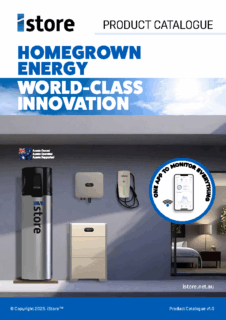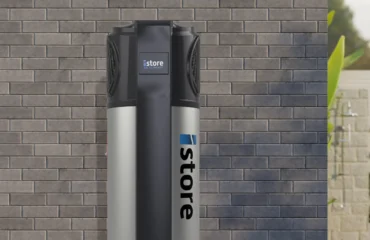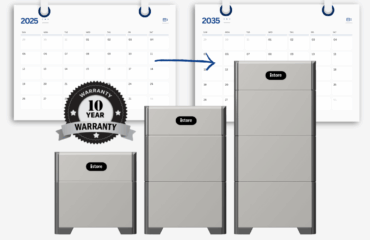Over 4 million Australian homes now have rooftop solar. That number keeps growing, and for good reason.
With rising energy costs and growing climate concerns, more households are turning to the bright Aussie sunshine to power their homes.
How does solar energy work?
Knowing the answer to this question will give you confidence when choosing a solar setup for your home.
What Is Solar Energy?
Solar energy is the light and heat that comes from the sun.
Solar panels capture that energy and turn it into electricity. This electricity can then power your home’s lights, appliances, and devices.
How Does Solar Energy Work to Produce Electricity?
1. Solar Panels Capture Sunlight
Each solar panel consists of solar cells made from a material called silicon. Silicon is a semiconductor that generates electricity when exposed to sunlight.
When sunlight (made up of tiny energy particles called photons) hits the solar cell’s surface, it excites the electrons in the silicon. This energy causes the electrons to move, creating an electrical flow.
The movement of these electrons generates direct current (DC) electricity.
2. The Inverter Converts DC to AC Power
But! Your home doesn’t use DC electricity; it uses alternating current (AC) power! So what now?
A device called a solar inverter converts the DC electricity into AC electricity. How? By rapidly switching the direction of the DC electricity, turning it from a straight, one-way flow into a wave-like, back-and-forth current.
This wave pattern matches the standard used in the Australian power grid (230 volts, 50 Hz), so the electricity can flow into your switchboard and safely power your home.
3. Your Home Uses Solar Power First
Your solar system prioritises self-generated electricity. That means your home will always use solar power before drawing any energy from the grid. This self-consumption helps reduce how much electricity you need to buy from your energy provider.
So, during the day when the sun is strong, your home will mostly run on solar power, lowering your power bills and your reliance on fossil-fuel-based grid energy.
4. Extra Power Goes to the Grid or a Battery
If your solar panels generate more electricity than your home needs at the time, the extra energy doesn’t go to waste.
Your system can send the excess electricity into the main electricity grid. When this happens, your energy retailer may pay you a feed-in tariff, a small credit on your power bill for each kilowatt-hour (kWh) you send back. The rate varies depending on your provider and the state in which you live.
Alternatively, excess energy can be stored in a solar battery for later use. This stored power becomes useful at night, during blackouts, or on overcast days when your panels aren’t generating enough electricity.
5. The Grid Backs You Up When Needed
Your solar system works during the day when sunlight is available, but electricity use continues well into the evening. When the sun isn’t shining and your panels aren’t producing power, your home still needs a reliable energy source.
If you don’t have a solar battery with stored excess solar energy, your home will automatically draw electricity from the grid whenever your solar production can’t meet your energy needs. No interruption or manual switching is involved; it all happens instantly and seamlessly in the background.
Key Components of a Solar Power System
Solar Panels
Solar panels do the crucial job of capturing sunlight. Each panel is made up of multiple solar cells, usually made from silicon, a material that reacts when exposed to sunlight. This reaction generates direct current (DC) electricity, which begins the process of powering your home.
How many solar panels do you need?
That depends on how much electricity you use and how much roof space you have. Most homes install systems between 5 kW and 10 kW, which generally means 14 to 28 panels, depending on the panel’s wattage (typically 350 W to 400 W each).
Where should you install solar panels?
- Pitched or Flat Roofs: Roof-mounted panels are the most common option. North-facing panels are ideal in Australia because they capture the most sunlight throughout the day. East- or west-facing panels can also work well, if you use more electricity in the morning or afternoon, rather than during the middle of the day.
- Ground Mounts: If roof space is limited or shaded, panels can be installed on ground-mounted frames. These systems require open land and are more common on farms or commercial properties.
- Carports or Pergolas: Panels can also be installed on secondary structures like carports, sheds, or pergolas, provided they get enough sun.
Inverters
Solar panels generate direct current (DC) electricity, but your home runs on alternating current (AC) electricity. An inverter converts DC into AC, making the energy from your solar panels usable for household appliances and devices.
Where is the inverter installed?
Near your switchboard, meter box, or sometimes inside your garage or on an external wall. The installer will choose a shaded, well-ventilated area to prevent overheating and to make the unit easy to access for maintenance or monitoring.
What are the main types of inverters?
- String Inverters: The most common option for residential systems. All panels connect in a single “string,” and the inverter manages the output from the whole group.
Pros: Cost-effective, reliable, easy to service.
Cons: If one panel is shaded or underperforming, it can affect the output of the entire string.
- Microinverters: Installed directly under each solar panel. Each panel has its own mini inverter.
Pros: Allows individual panel performance monitoring and better output if some panels are shaded or facing different directions.
Cons: Higher upfront cost, more components to install and service.
- Hybrid Inverters: A string inverter that also manages solar battery storage. Designed for homes that already have a battery or plan to install one later.
Pros: Battery-ready, more efficient energy management.
Cons: Slightly more expensive than standard string inverters.
How do you choose the right inverter for your home?
Choose
- A string inverter if you have consistent roof sunlight and no major shading issues.
- Microinverters if your roof faces multiple directions or has regular shading from trees or nearby structures.
- A hybrid inverter if you want to install a solar battery now or in the future.
Solar Batteries
Instead of returning excess electricity to the grid, a solar battery stores it for later use: at night, during blackouts, or when your panels aren’t producing enough.
Where are solar batteries installed?
Near your switchboard or inverter, either indoors (like in a garage) or outdoors in a weatherproof enclosure. The location needs to be cool, dry, and well-ventilated.
If your system includes a hybrid inverter, installation is typically simpler because the one device handles both the solar panel output and battery charging.
However, if your system uses a standard string inverter, you’ll usually need a separate battery inverter. This second inverter manages the flow of electricity to and from the battery, charging it when there’s extra solar power and discharging it when your home needs energy.
What are the most common battery sizes?
Battery capacity is measured in kilowatt-hours (kWh), telling you how much electricity the battery can store and later deliver.
Common sizes for Australian homes include
- 5–6 kWh: For small households with low to moderate energy use.
- 10–13 kWh: For average family homes with regular energy use, including evening consumption.
- 15+ kWh: For large homes, households with high energy use, or properties with electric vehicles.
Some systems allow for modular expansion, meaning you can start small and add more storage capacity over time.
How do you choose the right battery size?
That depends on
- Your daily energy usage
- How much excess solar power your system generates
- Whether you want backup power
- Your future plans, like adding an EV or increasing solar panel capacity
Monitoring Tools
Monitoring tools let you track how your solar power system is performing in real time.
They show how much
- Electricity your panels generate
- Your home uses
- Excess energy is exported to the grid
- Charge is in your battery
How do solar monitoring tools work?
Most modern inverters come with built-in monitoring capabilities. These connect to your home’s Wi-Fi and feed data to a mobile app or web portal. From there, you can log in and check your system’s performance anytime, anywhere.
If you’re using an iStore inverter, you can connect it to our WLAN dongle. This small device plugs into your inverter and links it to your home Wi-Fi, enabling full access to iStore’s online monitoring platform.
With the WLAN dongle, you can
- View live and historical solar performance data
- Understand your energy habits and make smarter usage choices
- Track your daily savings
- Maximise savings by shifting high-energy tasks (like laundry or charging an EV) to when solar output is highest
- Monitor how much power you’re exporting or importing
- Receive alerts if something goes wrong with the system
- Track your return on investment over time
Benefits of Using Solar Energy
Cost Savings
Generating solar energy for your home instead of relying solely on electricity from the grid significantly reduces your power bills.
Feeding excess energy back into the grid for a credit on your power bill helps offset the times when you do need to draw electricity from the grid.
Environmental Impact
Solar energy is a clean, renewable source that helps reduce greenhouse gas emissions. By generating electricity from sunlight, solar panels decrease reliance on fossil fuels, contributing to a reduction in air pollution and mitigating climate change.
Between January and March 2025, renewable energy accounted for 43% of electricity used in Australia’s main power grid, highlighting the growing impact of clean energy sources.
Energy Independence
By producing your own electricity, you become less dependent on the main power grid and less vulnerable to energy price fluctuations. This self-sufficiency ensures a more stable and predictable energy supply for your household.
Longevity
Modern solar panels are durable and built to last, typically with a lifespan of 25 years. This long-term investment continues to provide energy savings and environmental benefits for decades.
Government Incentives
The Australian government offers several incentives to encourage the adoption of solar energy.
- Small-Scale Renewable Energy Scheme (SRES): Tradable certificates (STCs) can be sold to offset the upfront cost of installing solar systems.
- Cheaper Home Batteries Program: Launching on July 1, 2025, this program offers up to a 30% reduction in the cost of home battery systems, aiming to support over one million new battery installations across Australia by 2030.
- State-Based Rebates: Various states provide additional incentives. For example, New South Wales offers rebates up to $2,400 for battery installations.
Why Choose iStore for Solar Energy Solutions?
iStore is a proudly Australian-owned, family-run company with over 25 years of experience in the solar and water heating industries. We understand our customers and what they need: affordable, high-quality products backed by strong warranties and local customer support.
Here are the products you can find within our range.
Solar Batteries
iStore solar batteries are scalable, safe, and durable.
Each battery is a stackable unit with a capacity of 5 kWh. Connecting two modules creates a 10 kWh battery, and connecting three modules gives you a 15 kWh battery. You can even connect two sets of 15 kWh batteries to achieve a maximum capacity of 30 kWh. So, no matter how high your energy needs are, we have you covered!
Our batteries are made of lithium iron phosphate (LFP). LFP batteries are known for being safer and more stable than other lithium-ion batteries. They have four layers of built-in protection, including temperature sensors that monitor and adjust the battery’s load to prevent short circuits, overcharging, overheating, and other potential faults.
They can also withstand Australia’s diverse climate, operating effectively in temperatures ranging from -20°C to 55°C.
Hybrid Inverters
iStore hybrid inverters integrate seamlessly with solar panel systems and iStore batteries, creating a complete energy solution that’s efficient and easy to manage.
We offer single-phase and three-phase hybrid inverters to suit a range of energy needs.
Single-phase inverters are ideal for standard homes with typical household energy usage, while three-phase inverters are better suited to larger homes or commercial properties with higher energy loads or appliances that require more consistent power distribution.
Heat Pumps
You can maximise your solar energy use by pairing your solar system with an iStore heat pump. Instead of using electricity from the grid, the heat pump draws power from your solar panels to heat and store water.
Our heat pumps extract heat from the surrounding air to warm the water inside the tank. By using renewable energy from both the sun and the air, iStore heat pumps significantly reduce electricity use and carbon emissions compared to traditional electric or gas water heaters.
The Future of Solar Energy
The future of solar energy is bright!
Solar systems are becoming smarter and more flexible, with better battery storage, more efficient panels, and advanced monitoring tools to help you get the most out of every ray of sunlight.
Government incentives and rebates continue to lower upfront costs, making solar a realistic option for more households.
As energy prices rise and environmental concerns grow, solar energy is set to play an even bigger role in how we power our homes.
FAQs
How Does Solar Energy Work?
Solar panels capture sunlight, and an inverter converts it into electricity. This electricity can then power a home or be stored in a battery for later use.
What Are the Main Components of a Solar Energy System?
The main components of a solar system are solar panels to capture sunlight, an inverter to convert the sunlight into usable electricity, an optional battery to store excess power, and monitoring tools to track system performance.
Can Solar Energy Work at Night?
Solar panels don’t produce electricity at night, but if you have a solar battery, you can use the excess energy stored during the day to power your home after sunset.
If you don’t have a solar battery, your home will automatically draw electricity from the grid at night.
How Efficient Is Solar Energy Compared to Other Renewable Sources?
Solar energy is highly efficient, especially in sunny regions like Australia. While wind and hydro can offer higher output in some settings, solar is more accessible, scalable, and easier to install.
Harness the Power of Solar Energy with iStore
How does solar energy work?
A solar system turns sunlight into electricity to power your home cleanly, conveniently, and cost-effectively.
Ready to make the switch to solar?
Explore the iStore range of smart, reliable solar solutions today. Then, call 1300 515 640 or fill out this online form, and we’ll help you out with expert advice and a free quote.




